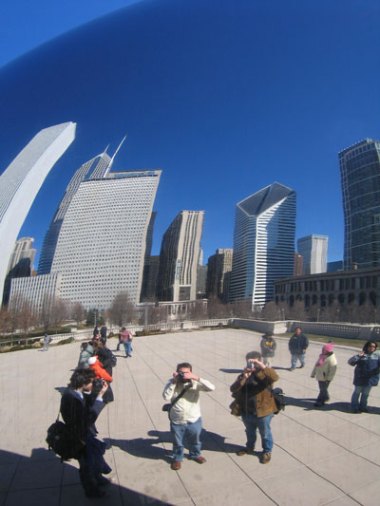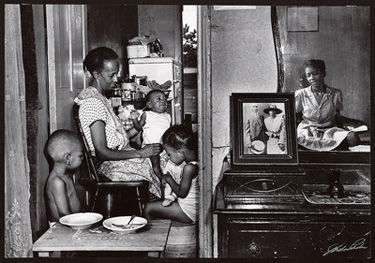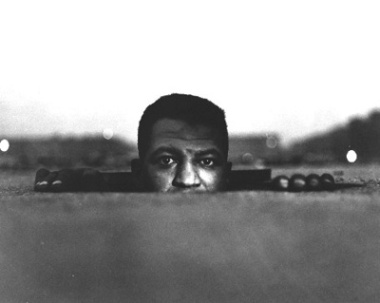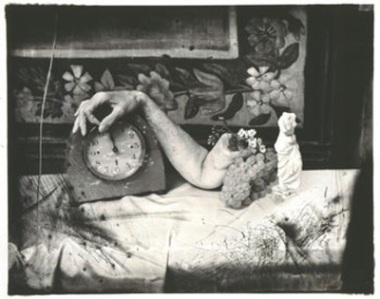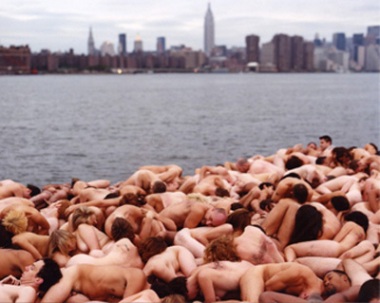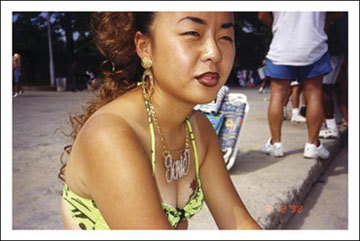
Korean-American artist Nikki S. Lee's photographs feature her involved in various – as she calls them – Projects. The image above is from 1998's The Hispanic Project, a series of photographs in which Lee changed her appearance so as to participate in Hispanic culture in New York City where she both studied (FIT, NYU) and now lives.
Over the course of several years, Lee has engaged in over a dozen of these Projects, including The Punk Project (1997), The Lesbian Project (1997), The Yuppie Project (1998), The Ohio Project (1999), The Exotic Dancers Project (2000), and The Hip Hop Project (2001).
The issues illuminated by these images are myriad and complex, but the one I latched onto as the most compelling was Lee's reliance on stereotypes throughout her Projects. Starting with the naming of the Projects themselves, Lee shows us not only the flexibility of culture and our movement through it, she also illustrates the strange "groupthink" that dominates our perceptions of people and groups. Before even looking at the images of each individual Project, I conjured up a mental image of what a person attempting to look like a member of that group would wear. My perceptions (read: "stereotypes") of these groups were essentially spot on – an image of Lee as a yuppie features her clad in well-tailored black clothing and exiting a boutique with a powder blue shopping bag, and an image of her as a resident of Ohio shows Lee in denim overalls with bleach-blonde hair.
My initial reaction to this was somewhat akin to shame; I felt the guilt of someone who unfairly categorizes people based on their appearance. But a bit of thought brought me to realize that we absolutely must stereotype people in order to mentally organize our world. The problem lies not in making visual associations between appearance and behavior, the problem arises when we rely on these associations (which are only assumptions based on experience both lived and mediated) to make our decisions for us. When we use stereotypes to pre-judge, then we are wrong. But to use them as we might a hand-drawn map (and also keep in mind the adage that "the map is not the territory"), then stereotypes might actually be able to serve us well.
Links
Nikki S. Lee Projects – Review in Afterimage (2001) by Joan Kee
Museum of Contemporary Photography: Nikki S. Lee
Leslie Tonkonow Gallery: Nikki S. Lee
 Instant Light: Tarkovsky Polaroids
Instant Light: Tarkovsky Polaroids “Upstate Invitational”
“Upstate Invitational”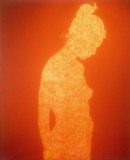 My previous post really unloaded on Suzanne Opton and, to a certain extent, portraiture itself. So in the spirit of balance (and ridding bad tastes from one's mouth) I am showing some portraits I do like.
My previous post really unloaded on Suzanne Opton and, to a certain extent, portraiture itself. So in the spirit of balance (and ridding bad tastes from one's mouth) I am showing some portraits I do like.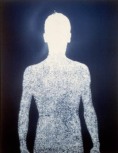 There's plenty of room in this work for my mind to enter and think about the energy and matter that make up the body, unlike so many conventional portraits that end at the surface of the body or face. The work is also as much about "people" as it is "a person." It's simultaneously universal and intimate – something that I rarely feel from a photo of a specific person's exterior surfaces.
There's plenty of room in this work for my mind to enter and think about the energy and matter that make up the body, unlike so many conventional portraits that end at the surface of the body or face. The work is also as much about "people" as it is "a person." It's simultaneously universal and intimate – something that I rarely feel from a photo of a specific person's exterior surfaces.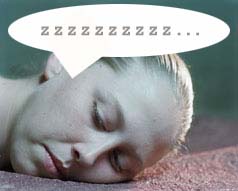 Which brings me to Suzanne Opton's Soldier exhibition. I sometimes worry that I'm not riled up enough about art, that I'm not moved by images to the extent that a visual studies student should be. But viewing Opton's images and hearing the accompanying lecture by critic Vicki Goldberg and Opton's own responses to the audience Q&A left me incensed. Goldberg's lecture was interesting; she presented a thorough history of war photography and portraits of soldiers through the years. But I was disappointed that despite talking about the precedence for Opton's aesthetic (the head posed with hands, the head lying on a surface), Goldberg made no mention of the symbolism of such a pose. The natural visual implications of these poses – submission, defeat, control, sorrow, death – were ignored.
Which brings me to Suzanne Opton's Soldier exhibition. I sometimes worry that I'm not riled up enough about art, that I'm not moved by images to the extent that a visual studies student should be. But viewing Opton's images and hearing the accompanying lecture by critic Vicki Goldberg and Opton's own responses to the audience Q&A left me incensed. Goldberg's lecture was interesting; she presented a thorough history of war photography and portraits of soldiers through the years. But I was disappointed that despite talking about the precedence for Opton's aesthetic (the head posed with hands, the head lying on a surface), Goldberg made no mention of the symbolism of such a pose. The natural visual implications of these poses – submission, defeat, control, sorrow, death – were ignored.
